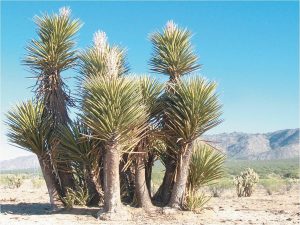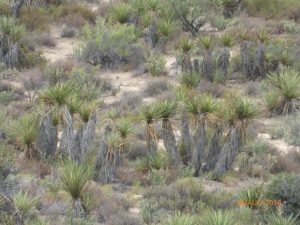October 8, 2014
We finally learned the difference between yucca and yuca. Yuca is the (relatively) well known tuber, a major agricultural staple, with high starch content. It is know by many names, including manioc, cassava, and tapioca.
Yucca, on the other hand, is a desert plant of which there are about fifty varieties. Yucca Schidigera is harvested to produce a wide range of products. This variety grows only in the California/Arizona desert and Baja California, Mexico.
Juice is extracted, using a Vincent screw press, from the trunk of the plant. This juice is made into products in three main categories:
The principal use is as a foaming agent where a foam that will not dissipate is desirable. This includes shampoos, where it adds “no tears” properties. In the beverage industry it is used to prepare root beer, slush products, foamy cocktail mixes, beer, juice and wine coolers. It is especially useful for maintaining natural foaming in low alcohol and non-alcohol root beers. Yucca extracts produce a rich, dense, frothy foam.
The second largest use is as an ingredient in animal foods. Yucca is used in animal feeds for the reduction of waste odors, for increasing the absorption of nutrients, and for protection from protozoal diseases in the feeds. Yucca extracts have ammonia-binding activity. When added to the diet, these pass through the digestive tract unabsorbed and are excreted in the feces. In the excreta, the yucca components bind to ammonia and certain other odiferous compounds and prevent them from being released into the air. Yucca extracts are used for ammonia and odor control in pig and poultry-raising facilities and in dog and cat foods.
The third major market is nutraceuticals. Yucca has long been used by the health foods industry as a nutrient supplement product. It is pressed into tablets, or it is mixed with water and alcohol to produce liquid tincture products. These are sold as premium health supplements. A wide range of benefits have been reported.
Yucca grows very slowly, largely because of the sparse rainfall available in desert regions. The plant lives for fifty to one hundred years. However, the trunks are large enough to be harvested in fifteen to twenty years. There is a sustainable agriculture program in Mexico which restricts harvest to one fifteenth of the available crop on a plot of land per year.
The plants can develop multiple trunks, like a double or triple Robeline. In these cases they harvest only a couple of the trunks from the plant.
The harvested trunks range from 6″ to 12″ in diameter, from 4′ to 8′ in length. These have an 80% moisture content, and the soluble solids typically run 8º or 9º Brix. However they can reach 15º or even 20º Bx, depending on conditions.
A Vincent Model KP-16 screw press is being used successfully to extract juice from the trunk of the plant. The trunks are first shredded and then run through our screw press. The action in the screw press has a further shredding action, and about 20% by weight is recovered as press liquor. The action in the press is similar to pressing corn husk or sugar cane bagasse.
Heavier pressing can yield higher juice yields. However since both the press liquor and the press cake (fiber) are made into saleable products, there is a need to leave liquid, with its soluble solids, in the cake.
The liquor is filtered and then concentrated, usually to 50º Bx. This liquid product is easy to handle in the beverage industry, it can be added to farm animal drinking water, and it can be blended into liquid nutraceuticals. It can even be applied to hard-packed soils to open them up for cultivation.
The press cake from the screw press is dried, either by the sun or in a rotary drum dryer. Then it is ground to a powder. In this form is can be blended, in ppm quantities, with farm animal feeds. Or it can be formed into tablets, for the nutraceutical market.


